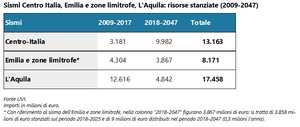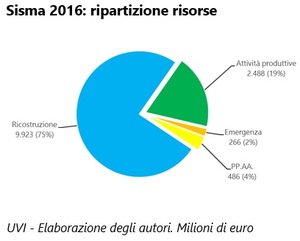Terremoti. L'Aquila 2009, Pianura padana 2012, Centro Italia 2016: risorse e leggi per la ricostruzione

Il 24 agosto 2016, alle 3.36, un terremoto di magnitudo Richter ML 6.0 ha colpito il Centro Italia distruggendo Accumoli, Amatrice, Arquata del Tronto e Pescara del Tronto. Alle 4.33 una nuova scossa, stavolta di magnitudo 5.4, ha distrutto Norcia. Da quel momento il Centro Italia ha tremato più di 72 mila volte, con un picco registrato, alle 7.40 del 30 ottobre, tra le province di Macerata, Perugia e Ascoli Piceno: con una magnitudo 6.5 è stato il terremoto più forte avvenuto in Italia dopo quello, di magnitudo Mw 6.8, che nel 1980 ha distrutto l'Irpinia. Il 18 gennaio il sisma ha colpito ancora, in Abruzzo, nel settore Campotosto-Montereale.
Il bilancio di questa sequenza sismica è stato pesantissimo in termini di vite umane perdute, di economia sconvolta, di patrimonio culturale devastato. I danni materiali, stimati dalla Protezione civile in 23 miliardi e 530 milioni di euro, sono andati ad aggiungersi a quelli, già ingenti, degli ultimi due gravi sismi che hanno colpito l'Italia nel 2009, all'Aquila, e nel 2012 nella pianura padana.
Questo studio analizza le risorse finanziarie messe in campo per far fronte ai disastri degli ultimi 8 anni e approfondisce, per l'ultimo sisma, anche le risposte normative: tre decreti legge modificati e integrati da innumerevoli novelle - ultimo a intervenire, il 1° agosto, il decreto Mezzogiorno - che si aggiungono a 35 ordinanze del commissario straordinario e ad altre 26 di protezione civile.
Earthquakes. Central Italy 2016, Emilia 2012, L’Aquila 2009: reconstruction resources and laws
On 24 August 2016, at 3:36 am, an earthquake measuring 6.0 on the Richter magnitude scale rocked central Italy, destroying the towns of Accumoli, Amatrice, Arquata del Tronto and Pescara del Tronto. At 4:33 am another tremor, of magnitude 5.4, brought destruction to Norcia. Since that moment, over 70,000 tremors have been recorded in central Italy, with seismic activity peaking at 7:40 am of 30 October, in the provinces of Macerata, Perugia and Ascoli Piceno. With a magnitude of 6.5, it was the most powerful earthquake that ever struck Italy, after the one that destroyed the Irpinia area back in 1980, which measured 6.8 on the moment magnitude scale. On 18 January, another quake rocked the Abruzzi region, in the area of Campotosto-Montereale.
The aftermath of this seismic sequence was absolutely terrible, in terms of death toll, disrupted economy, devastated cultural heritage. The Civil Defence estimated that material damage totalled about 23,530,000 Euros, which adds on to the significant damage caused by the previous two earthquakes, which struck L'Aquila in 2009 and the Po Valley in 2012.
This study analyses the financial resources fielded to face the natural disasters of the past eight years and zeroes in, for the last quake, on the regulatory response too: three decree-laws, and later amendments which followed 35 decrees by the Special Commissioner and 26 decrees of the Civil Defence.







 Focus
Focus